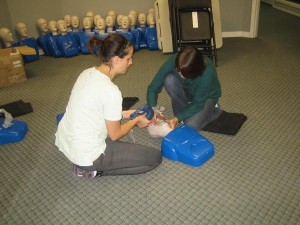
Honolulu CPR stands as the best training provider of CPR programs in Honolulu, Hawaii. There are basic CPR and advanced CPR programs available at very flexible schedules; even private classes are available upon request. Other providers do not have better quality programs than Honolulu CPR. Our programs used to be monopolized by people working or were studying in healthcare, but not anymore. Even stay-at-home parents and people in office jobs sign up to get basic CPR training. With Honolulu CPR, you’re sure to get the certification you need.
Basic Life Support
Basic Life Support is a concept used to describe the American Heart Association’s suggested techniques and guidelines when giving cardiopulmonary resuscitation to an unresponsive victim. BLS training is done to prepare rescuers for one-person CPR rescue when a victim collapses out of a clinical setting. BLS guidelines cover the correct way to give chest compressions, rescue breaths, and defibrillation. The steps in the “Chain of Survival” is also an important part of BLS.
There are no pre-requisites for any of the BLS programs.
- Basic CPR for the public – The general public program is an optional certification program, meaning that students are not required to take the post-test (a skills test) that serves as a certifying examination. Basic CPR training is four hours long, without an available re-certification class. The program teaches the basics: compressions, breaths, and defibrillation, as well as a few first aid skills.
- Basic CPR for HCPs – This program runs longer than the public program for CPR training, running for 4.5 hours. It teaches the same basics of one-person rescue, but tailors the lessons for HCPs. Re-certification is not available. Students need to pass the skills test and written exam to become certified rescuers.
- Basic Life Support for HCPs – This program runs for 4.5 hours too, and focuses on both one-person and two-person CPR rescue. The same basics in chest compressions and rescue breaths are included in this training program. Trainees are likewise introduced to the Basic Life Support guidelines and technique updates. A pre-test must be passed to enter BLS for HCP training, as well as a set of post-tests to become certified.
Advanced Life Support
ALS training is only for healthcare professions. A pre-requisite is required for ACLS and PALS training: students must have a valid BLS certificate before he or she can qualify for the program. While ALS programs still teach the basics of BLS, the programs go more in-depth and are more complex, teaching students how to give CPR in a clinical setting with complete equipment. Pharmacology and equipment use is an important lesson given to trainees.
- Advanced Cardiac Life Support – This program runs for 16 hours, over two days. The approach for ACLS is towards adult victims, so the lessons incorporate adult dosages for medication and equipment sized used on adults. Students are familiarized with the crash cart and all the medications and equipment like endotracheal tubes it contains. Re-certification is 5 to 6 hours long.
- Pediatric Advanced Life Support – This program runs for 14 hours, over two days as well. The program structure and curriculum is the same as ACLS but focuses on management of pediatric victims. Giving CPR to an adult is quite different from giving it to an infant or younger child. Re-certification is 6 to 8 hours long.